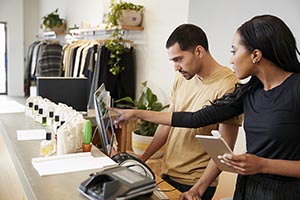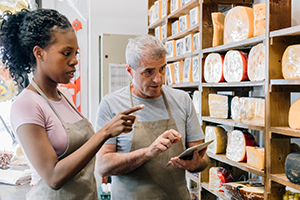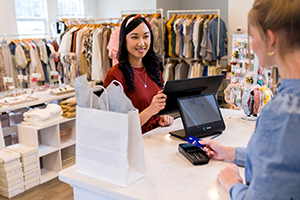Your brand is an essential part of what separates you from your competitors. We'll look at how a modern point of sale (POS) allows you to weave your company’s look and feel into the purchasing experience and beyond.
Branding is more than your logo and color scheme—it’s the personality of your business and it signals to customers who you are. Clear, consistent and catchy branding can help your business stand out in a sea of competitors—but how can you be sure your efforts will garner the appropriate returns?
A modern POS can help you tell your company’s story throughout the customer journey, plus help you make informed decisions based on customer analytics, so you know your efforts will produce an ROI.
Omnichannel branding
When customers interact with your business, they’re doing so from multiple points of entry. Your storefront, social media presence, website and any advertisements you’re running are all places where your brand tells your business’ story.
An omnichannel approach to marketing your brand is the strongest way to improve your company’s online presence because it’s cohesive, meaning each potential customer is given the same “story” about your company. Most importantly, it’s a model that consumers have come to expect.
Think about how your brand is seen from the customer’s perspective: How did the customer discover you? Is it clear from that point of entry what your business is? What about your company’s personality—is that clearly represented? Don’t forget about returning customers, either—how is your brand marketing helping them keep your company top of mind? In a world where 71% of small business have a website, the importance of stand-out branding cannot be overstated.
Omnichannel marketing allows you to promote your brand across multiple platforms (like social media, paid ad campaigns and email newsletters) in a consistent, cohesive way. The brand experience should be the same from platform to platform. Let’s look at how customer data and other analytics gathered at the POS can help you strengthen your brand’s identity.
Branding the customer POS experience
Depending on the size of your business, you may have one or multiple customer-facing displays (CFDs), or you may even have kiosk-style registers; these displays provide an opportunity to infuse your business’ personality into the customer journey.
With a modern POS system, updating the splash screen on CFDs and kiosks is easy, with many CDFs supporting multiple rotating messages that you can use to promote new items and sales or to simply relay information.
Align the messaging on your splash screen with your brand: Does the tone of voice match how your business is presented elsewhere? Is your logo clearly present? Do the colors and fonts match your brand’s style? Take advantage of these mini moments to help mold the picture of your business that customers have in their heads.
Branding your website
Your business’ website acts as an ambassador for your business, and any missing or incorrect information on your site is a direct reflection of who you are as a company. General information like operating hours, phone number and location should be accurate, be easy to access and match what’s listed on your other platforms. Provide a clear path for customers to follow your social platforms for continued engagement. Again, make sure your logo is clear and your brand colors are accurate, but not overwhelming to the point they distract from your menu or catalog items.
The saying about a picture being worth a thousand words rings as true online as anywhere else. In fact, 59% of consumers think visual data is more important than text data, regardless of what they’re shopping for. Images convey both information and emotion, so not only should your product or menu photos be helpful references, but they should also match the tone of your brand.
For instance, if you run a fast-casual bistro, you wouldn’t want to photograph your food on a fancy china plate—it would give potential customers the wrong idea. For quick visual communication, photograph products on a simple white background; this also helps to not distract from other branding on site.
Data-informed merchandising
Merchandising is as part of your brand, too. The items you spotlight, the way you choose to elevate them and where you promote them all convey the look, feel and attitude of your company.
Before merchandising any product or service, consider this statistic: data-driven organizations are 23 times more likely to acquire customers. Apply that model to merchandising; information collected through your POS can help you make good merchandising decisions, whether you’re choosing items for an in-store display or highlighting a product line on Instagram. A modern POS will help you determine top sellers, even providing more granular details like favorite places to sit in your restaurant or gaps in your inventory. Matching what products or services individual customers enjoy the most allows you to develop highly attuned marketing efforts.
Top sellers can help you decide how to merch high-traffic areas like front endcaps or register and window displays. With cloud-based inventory management (available with talech POS) you can quickly see when bestsellers are back in stock and let your customers know with a social media update or email.
The goal of branding is to get your business recognized, to stand apart from others and to be easily identifiable for repeat customers. By using the data and tools available through your modern POS, you can make thoughtful, worthwhile updates to your business that will deliver results.
Improve your business’ brand with these POS merchant services.











































